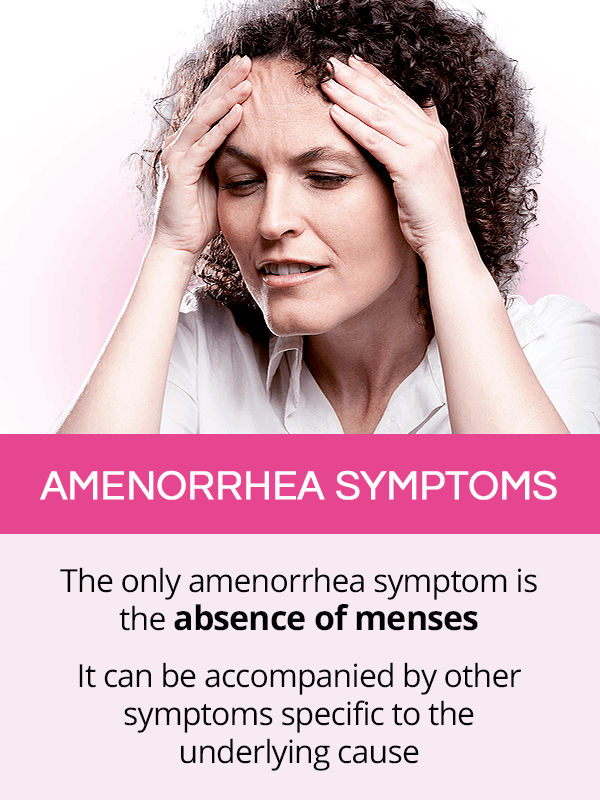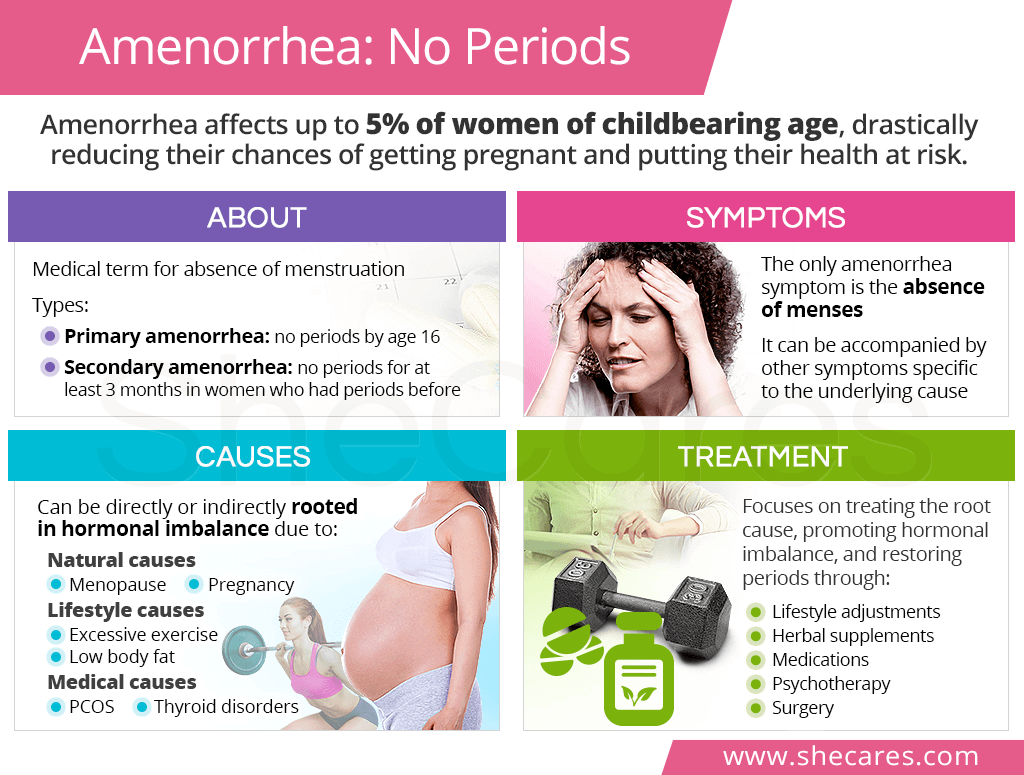What is Amenorrhea?

As aforementioned, absence of menstruation is called amenorrhea. It is one of the most common menstrual disorders.
Types of Amenorrhea
Amenorrhea is classified into two types:2,3
Primary amenorrhea is defined as an absence of initiation of menses by the age of 16.
Secondary amenorrhea is defined as an absence of menses for at least three months or more in women who previously menstruated.
Amenorrhea Symptoms

The main amenorrhea symptom is absence of menses.
However, because amenorrhea is a symptom of other conditions, there might be additional associated symptoms that will depend on the cause of those conditions, such as:
- Milky nipple discharge
- Hair loss
- Headaches
- Vision changes
- Excess facial hair
- Pelvic pain
- Acne
- Hot flashes
Amenorrhea Causes
There are a wide range of potential amenorrhea causes, which can be categorized as primary and secondary and include the following:
Primary Amenorrhea Causes
While some cases of primary amenorrhea are unknown, most are linked to congenital abnormalities that result in:
Disturbed hormone production or release from the hypothalamus or pituitary gland
Ovarian dysfunction
Abnormal anatomy of the reproductive tract
Secondary Amenorrhea Causes
The majority of the causes of secondary amenorrhea relate directly or indirectly to hormonal imbalance, whether from natural causes, unhealthy lifestyle practices, or medical causes.
Because of their number, finding the exact cause can sometimes be challenging. Nevertheless, most common secondary amenorrhea causes include the following:

Natural Causes
Lifestyle Causes
- Low body fat
- Obesity
- Eating disorders
- Prolonged stress
- Poor nutrition
- Sudden weight gain or loss
- Strenuous exercise
Medical Causes
- Birth control discontinuation
- PCOS
- Thyroid disorders
- Pituitary tumors
- Uterine scarring
- Hyperprolactinaemia
- Side effects of medications
- Chemo- or radiation therapy
Amenorrhea Risks & Effects
As with any physiological disturbance in the female body, absence of menstruation can have negative effects on women's health. The following are examples of how amenorrhea risks and effects can manifest:
Infertility
Women suffering from amenorrhea are also likely to struggle with infertility. Without ovulation, natural pregnancy cannot take place. However, once the underlying cause is treated, most of the time menstrual cycles return, and fertility is restored.
Osteoporosis
Loss of menstrual cycles have been associated with an increased risk of osteoporosis, including bone loss, thinning, and likelihood of fractures. The highest prevalence was seen in those who were diagnosed with amenorrhea or oligomenorrhea in their adolescene.4
High Cholesterol
Untreated amenorrhea resulting from hormonal imbalance can cause disruption of the ratio between high-density lipoprotein (HDL) and low-density lipoprotein (LDL).5 Improper cholesterol ratio is one of the main risk factors of heart disease.
Amenorrhea Treatment
Amenorrhea treatment will hugely depend on what caused it in the first place. While some women might be able to restore their periods with natural approaches, others might need more invasive treatments.
Approaches will focus on resolving the underlying cause and promoting hormonal balance. They are as follows:

Lifestyle Changes
Exercise routine modifications to consist of 150 minutes of moderate-intensity activity6
Diet adjustments to contain a colorful variety of vegetables, lean protein, complex carbs, and healthy fats
Stress-relief techniques, like meditation, to reduce high cortisol levels' effects on hormonal balance
Alternative Medicine
Phytoestrogenic supplements, like red clover, to balance hormones with plant-based estrogenic compounds
Hormone-regulating supplements, like Macafem, to safely nourish the endocrine glands for optimal hormone production and menstrual health
Conventional Medicine
Medications, if necessary, will be tailored to the specific cause of amenorrhea and might include thyroid medications, birth control pills, hormone replacement therapy (HRT), and others. In many cases, medications can only relieve symptoms, not treat the root cause, and come with potentially serious side effects.
Psychotherapy might be beneficial for those whose absence of menstruation is a result of eating disorders, such as anorexia or bulimia nervosa.
Surgery may be necessary in the case of ovarian cysts, uterine adhesions, or scar tissue that might be behind the absence of periods.
Key Takeaways
Though at first it might feel like a dream come true for many women, absence of menstruation – medically known as amenorrhea – is a menstrual disorder that requires prompt attention. Its two types are differentiated by its onset with primary amenorrhea defined as having no periods by the age of 16 and secondary amenorrhea defined as absence of menstruation for at least three months after having periods in the past. Among the most common causes are hormonal imbalances due to unhealthy lifestyle habits or medical conditions, besides natural causes like pregnancy or menopause. Treatment approaches for absence of menses focus on resolving the underlying cause and achieving hormonal balance in order to restore periods and fertility. They can consist of lifestyle adjustments; herbal supplements, like Macafem; or conventional medicine.
Sources
- Cleveland Clinic. (2014). Amenorrhea. Retrieved November 28, 2019 from https://my.clevelandclinic.org/health/diseases/3924-amenorrhea
- Fertility and Sterility. (1994). Amenorrhea during the reproductive years - is it safe? Retrieved November 28, 2019 from https://www.fertstert.org/article/S0015-0282(16)56808-3/pdf
- Mayo Clinic. (2019). Amenorrhea. Retrieved November 28, 2019 from https://www.mayoclinic.org/diseases-conditions/amenorrhea/symptoms-causes/syc-20369299
- Medline Plus. (2018). Absence of menstruation (amenorrhea). Retrieved November 28, 2019 from https://medlineplus.gov/ency/imagepages/17088.htm
- Medline Plus. (2018). Absence of menstrual periods - secondary. Retrieved November 28, 2019 from https://medlineplus.gov/ency/article/001219.htm
- Seminaries in Reproductive Medicine. (2017). Hypothalamic Amenorrhea and the Long-Term Health Consequences. Retrieved November 28, 2019 from https://www.ncbi.nlm.nih.gov/pmc/articles/PMC6374026/
- Stat Pearls. (2019). Amenorrhea. Retrieved November 28, 2019 from https://www.ncbi.nlm.nih.gov/books/NBK482168/
Footnotes:
- Eunice Kennedy Shriver National Institute of Child Health and Human Development. (2017). Who is at risk of amenorrhea? Retrieved November 28, 2019 from https://www.nichd.nih.gov/health/topics/amenorrhea/conditioninfo/risk
- Eunice Kennedy Shriver National Institute of Child Health and Human Development. (2017). What causes amenorrhea? Retrieved November 28, 2019 from https://www.nichd.nih.gov/health/topics/amenorrhea/conditioninfo/causes
- American Family Physician. (2013). Amenorrhea: An Approach to Diagnosis and Management. Retrieved November 28, 2019 from https://www.aafp.org/afp/2013/0601/p781.html
- Acta obstetrician et Gynecologica Scandinavica. (2009). Reduced bone mineral density in adult women diagnosed with menstrual disorders during adolescence. Retrieved November 28, 2019 from https://www.ncbi.nlm.nih.gov/pubmed/19353333
- Better Health Channel. (2018). Menstruation - athletic amenorrhea. Retrieved November 28, 2019 from https://www.betterhealth.vic.gov.au/health/ConditionsAndTreatments/menstruation-athletic-amenorrhoea
- American Heart Association. (2018). American Heart Association Recommendations for Physical Activity in Adults and Kids. Retrieved November 28, 2019 from https://www.heart.org/en/healthy-living/fitness/fitness-basics/aha-recs-for-physical-activity-in-adults


